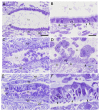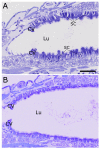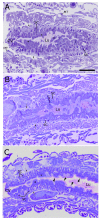Histopathological Effects of Bt and TcdA Insecticidal Proteins on the Midgut Epithelium of Western Corn Rootworm Larvae (Diabrotica virgifera virgifera)
- PMID: 28481307
- PMCID: PMC5450704
- DOI: 10.3390/toxins9050156
Histopathological Effects of Bt and TcdA Insecticidal Proteins on the Midgut Epithelium of Western Corn Rootworm Larvae (Diabrotica virgifera virgifera)
Abstract
Western corn rootworm (WCR, Diabrotica virgifera virgifera LeConte) is a major corn pest in the United States, causing annual losses of over $1 billion. One approach to protect against crop loss by this insect is the use of transgenic corn hybrids expressing one or more crystal (Cry) proteins derived from Bacillus thuringiensis. Cry34Ab1 and Cry35Ab1 together comprise a binary insecticidal toxin with specific activity against WCR. These proteins have been developed as insect resistance traits in commercialized corn hybrids resistant to WCR feeding damage. Cry34/35Ab1 is a pore forming toxin, but the specific effects of Cry34/35Ab1 on WCR cells and tissues have not been well characterized microscopically, and the overall histopathology is poorly understood. Using high-resolution resin-based histopathology methods, the effects of Cry34/35Ab1 as well as Cry3Aa1, Cry6Aa1, and the Photorhabdus toxin complex protein TcdA have been directly visualized and documented. Clear symptoms of intoxication were observed for all insecticidal proteins tested, including swelling and sloughing of enterocytes, constriction of midgut circular muscles, stem cell activation, and obstruction of the midgut lumen. These data demonstrate the effects of these insecticidal proteins on WCR midgut cells, and the collective response of the midgut to intoxication. Taken together, these results advance our understanding of the insect cell biology and pathology of these insecticidal proteins, which should further the field of insect resistance traits and corn rootworm management.
Keywords: Bacillus thuringiensis; Cry34Ab1; Cry35Ab1; Diabrotica virgifera virgifera; histopathology; western corn rootworm.
Conflict of interest statement
The authors declare no conflict of interest.
Figures





Similar articles
-
RNAi induced knockdown of a cadherin-like protein (EF531715) does not affect toxicity of Cry34/35Ab1 or Cry3Aa to Diabrotica virgifera virgifera larvae (Coleoptera: Chrysomelidae).Insect Biochem Mol Biol. 2016 Aug;75:117-24. doi: 10.1016/j.ibmb.2016.06.006. Epub 2016 Jun 19. Insect Biochem Mol Biol. 2016. PMID: 27334721
-
Patterns of Gene Expression in Western Corn Rootworm (Diabrotica virgifera virgifera) Neonates, Challenged with Cry34Ab1, Cry35Ab1 and Cry34/35Ab1, Based on Next-Generation Sequencing.Toxins (Basel). 2017 Mar 30;9(4):124. doi: 10.3390/toxins9040124. Toxins (Basel). 2017. PMID: 28358336 Free PMC article.
-
Evidence of western corn rootworm (Diabrotica virgifera virgifera LeConte) field-evolved resistance to Cry3Bb1 + Cry34/35Ab1 maize in Nebraska.Pest Manag Sci. 2022 Apr;78(4):1356-1366. doi: 10.1002/ps.6752. Epub 2021 Dec 19. Pest Manag Sci. 2022. PMID: 34873825
-
RNAi as a management tool for the western corn rootworm, Diabrotica virgifera virgifera.Pest Manag Sci. 2016 Sep;72(9):1652-63. doi: 10.1002/ps.4324. Epub 2016 Jun 27. Pest Manag Sci. 2016. PMID: 27218412 Review.
-
Safety considerations derived from Cry34Ab1/Cry35Ab1 structure and function.J Invertebr Pathol. 2017 Jan;142:27-33. doi: 10.1016/j.jip.2016.07.019. Epub 2016 Jul 29. J Invertebr Pathol. 2017. PMID: 27480405 Review.
Cited by
-
Dissecting Out the Molecular Mechanism of Insecticidal Activity of Ostreolysin A6/Pleurotolysin B Complexes on Western Corn Rootworm.Toxins (Basel). 2021 Jun 29;13(7):455. doi: 10.3390/toxins13070455. Toxins (Basel). 2021. PMID: 34209983 Free PMC article.
-
Up-regulation of apoptotic- and cell survival-related gene pathways following exposures of western corn rootworm to B. thuringiensis crystalline pesticidal proteins in transgenic maize roots.BMC Genomics. 2021 Sep 4;22(1):639. doi: 10.1186/s12864-021-07932-4. BMC Genomics. 2021. PMID: 34479486 Free PMC article.
-
Editorial for Special Issue: The Insecticidal Bacterial Toxins in Modern Agriculture.Toxins (Basel). 2017 Dec 9;9(12):396. doi: 10.3390/toxins9120396. Toxins (Basel). 2017. PMID: 29232854 Free PMC article. No abstract available.
-
Structural and functional insights into the first Bacillus thuringiensis vegetative insecticidal protein of the Vpb4 fold, active against western corn rootworm.PLoS One. 2021 Dec 20;16(12):e0260532. doi: 10.1371/journal.pone.0260532. eCollection 2021. PLoS One. 2021. PMID: 34928980 Free PMC article.
-
IPD072Aa from Pseudomonas chlororaphis Targets Midgut Epithelial Cells in Killing Western Corn Rootworm (Diabrotica virgifera virgifera).Appl Environ Microbiol. 2023 Mar 29;89(3):e0162222. doi: 10.1128/aem.01622-22. Epub 2023 Feb 27. Appl Environ Microbiol. 2023. PMID: 36847510 Free PMC article.
References
-
- Metcalf R.L. Foreword. In: Krysan J.L., Miller T.A., editors. Methods for the Study of Pest Diabrotica. Springer; New Youk, NY, USA: 1986. pp. vii–xv.
-
- Narva K.E., Siegfried B.D., Storer N.P. Transgenic approaches to western corn rootworm control. Adv. Biochem. Eng. Biotechnol. 2013;136:135–162. - PubMed
-
- Environmental Protection Agency (EPA) Biopesticides Registration Action Document. Bacillus thuringiensis Cry3Bb1 Protein and the Genetic Material Necessary for Its Production (Vector PV-ZMIR13L) in MON 863 Corn (OECD Unique Identifier: MON-ØØ863-5) [(accessed on 6 May 2017)]; Available online: https://www3.epa.gov/pesticides/chem_search/reg_actions/registration/dec....
-
- Environmental Protection Agency (EPA) Biopesticides Registration Action Document. Modified Cry3A Protein and the Genetic Material Necessary for its Production (Via Elements of pZM26) in Event MIR604 Corn SYN-IR604-8. [(accessed on 6 May 2017)]; Available online: http://www3.epa.gov/pesticides/chem_search/reg_actions/pip/mcry3a-brad.pdf.
MeSH terms
Substances
LinkOut - more resources
Full Text Sources
Other Literature Sources

